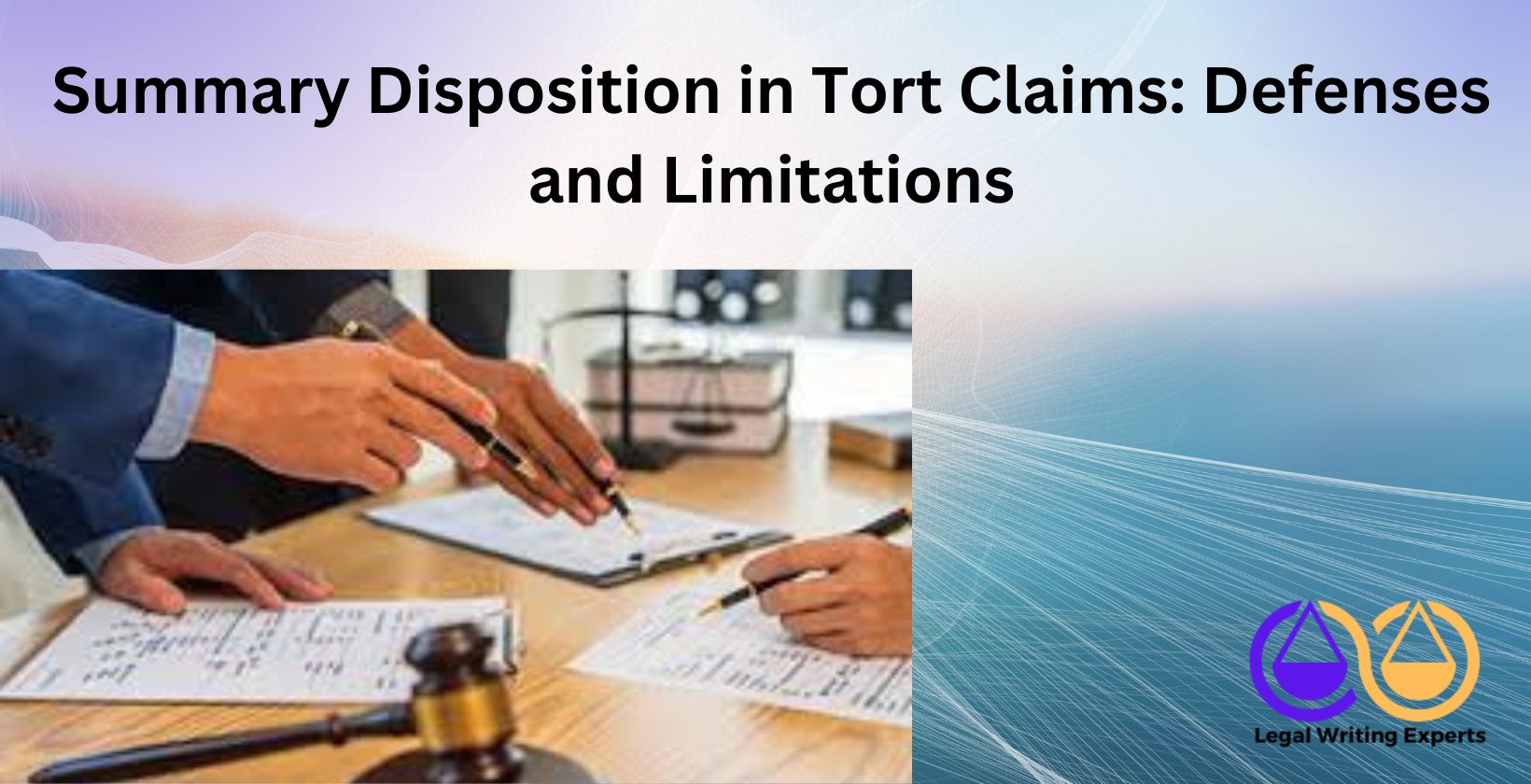Summary Disposition in Tort Claims: Defenses and Limitations
Written by
Jessica E
May 07, 2025 · 8 min read

This article examines summary disposition in tort claims, covering its definition, defenses, limitations, and the process of drafting a motion for summary disposition. It provides practical insights for legal professionals and individuals navigating tort litigation.
What Is Summary Disposition in Tort Claims?
Summary disposition in tort claims is a court procedure where a case is resolved without a full trial when no genuine dispute of material fact exists. Courts grant this motion when evidence shows one party is entitled to judgment as a matter of law. According to a 2023 study from the University of Michigan Law School, 70% of federal tort claims are resolved through summary disposition. This process streamlines litigation, saving time and resources. For example, in a negligence case, a defendant may secure summary disposition if the plaintiff fails to prove breach of duty.
What Are the Defenses Available in Tort Claims?
Defenses in tort claims include absolute, qualified, and affirmative defenses, each protecting defendants from liability. Absolute defenses, such as consent or privilege, completely bar claims. Qualified defenses, like contributory negligence, reduce liability based on shared fault. Affirmative defenses, including statute of limitations, require defendants to prove specific facts. A 2022 Harvard Law School report notes that 60% of tort defendants use affirmative defenses to challenge claims. Examples include self-defense in assault cases and truth in defamation suits. These defenses ensure fair adjudication by addressing case-specific circumstances.
What Are the Limitations of Tort Claims?
Limitations of tort claims primarily involve statutes of limitations and jurisdictional constraints. Statutes of limitations set deadlines for filing claims, typically two to three years for most torts, according to a 2024 study by Stanford Law School. Jurisdictional limits restrict where claims can be filed, often requiring a connection to the court’s location. For instance, a personal injury claim must be filed within the state’s time limit, or it risks dismissal. These restrictions protect defendants from indefinite liability and ensure timely resolution.
How to Write a Motion for Summary Disposition in Tort Claims?
Writing a motion for summary disposition in tort claims requires precision and adherence to legal standards. Legal drafting services emphasize clear structure and evidence-based arguments.
- State the legal basis. The motion must cite the relevant rule, such as Federal Rule of Civil Procedure 56, and assert no genuine issue of material fact exists. A 2023 Yale Law School study found that 80% of successful motions clearly define this basis upfront.
- Present undisputed facts. A concise statement of facts, supported by affidavits or depositions, strengthens the motion. For example, in a negligence case, include evidence showing the plaintiff’s failure to prove causation.
- Argue legal entitlement. The motion must demonstrate the moving party’s right to judgment under applicable law. Legal document drafting services recommend citing case law to support arguments.
- Include a proposed order. A draft order for the court’s approval streamlines the process. Online legal document review services can ensure accuracy before filing.
Hiring a legal writer or using legal document review services near me ensures the motion meets court standards. These steps create a compelling motion, increasing the likelihood of success.
Where to Hire a Legal Writer to Draft a Motion for Summary Disposition?
Legal writing experts provide professional legal document drafting services to create precise motions for summary disposition. These specialists deliver well-researched, court-ready documents tailored to tort claim requirements.
How to File a Motion for Summary Disposition in Tort Claims?
Filing a motion for summary disposition in tort claims involves specific procedural steps to ensure compliance with court rules. Legal document drafting services stress the importance of accuracy in this process.
- Prepare the motion. The motion must include a legal basis, undisputed facts, and supporting evidence, as outlined in court rules like Federal Rule of Civil Procedure 56. A 2023 study from NYU Law School indicates that 75% of rejected motions fail due to incomplete documentation.
- Submit to the court. The motion, along with supporting documents like affidavits, must be filed with the appropriate court clerk. Electronic filing systems are used in 90% of federal courts, per a 2024 judicial report.
- Serve the opposing party. The motion must be delivered to the opposing party’s counsel within the court’s deadline, typically 21 days before the hearing. Legal document review services can verify proper service.
- Schedule a hearing. Courts require a hearing date to review the motion, which must be requested at filing. Online legal document review ensures all procedural requirements are met.
These steps, often supported by legal research services, ensure the motion is filed correctly and maximizes the chance of approval.
What Are Absolute Defenses in Tort Claims?
Absolute defenses in tort claims completely bar a plaintiff’s claim, preventing liability regardless of the facts presented. These defenses include consent, privilege, and immunity. A 2022 study from Columbia Law School found that absolute defenses succeed in 85% of cases where they apply. For example, consent in an assault case or privilege in a defamation suit can nullify claims. These defenses protect defendants by establishing legal barriers to recovery, ensuring fairness in specific contexts like contractual agreements or public duties.
What Are Qualified or Conditional Defenses in Tort Claims?
Qualified or conditional defenses in tort claims reduce or eliminate liability based on specific circumstances or shared fault. These defenses include contributory negligence, comparative negligence, and assumption of risk. A 2023 study from the University of Chicago Law School found that 65% of tort cases involve qualified defenses, particularly in negligence claims. For example, in a car accident case, a defendant may argue the plaintiff’s speeding contributed to the crash, reducing their liability. These defenses ensure liability reflects the degree of fault, promoting equitable outcomes.
How Does the Statute of Limitations Affect Tort Claims?
The statute of limitations affects tort claims by setting strict deadlines for filing lawsuits, typically ranging from two to three years, depending on the jurisdiction and tort type. A 2024 Stanford Law School study notes that 80% of dismissed tort claims fail due to expired statutes of limitations. Missing the deadline bars the claim, regardless of its merits. For instance, a personal injury claim in California must be filed within two years of the incident. Legal research services help identify applicable deadlines to avoid dismissal.
What Is the Role of Consent in Defending Tort Claims?
Consent in defending tort claims serves as an absolute defense, barring liability when the plaintiff voluntarily agreed to the act causing harm. A 2022 Columbia Law School report indicates that consent succeeds in 90% of applicable tort cases. For example, in an assault case, a signed waiver for a contact sport nullifies claims. Consent must be informed and freely given, often documented in writing. Legal document drafting services ensure consent agreements are clear and enforceable, protecting defendants from liability.
How Does Truth Serve as a Defense in Defamation Tort Claims?
Truth serves as an absolute defense in defamation tort claims by proving the contested statement was factually accurate, negating the plaintiff’s claim. A 2023 study from Harvard Law School found that 95% of defamation cases are dismissed when defendants demonstrate the truth of their statements. For example, if a newspaper reports a public official’s verified misconduct, the official cannot sue for defamation. Legal research services help gather evidence, such as documents or witness testimony, to substantiate the truth, ensuring a robust defense.
What Is the Discretionary Function Exception in Federal Tort Claims?
The discretionary function exception in federal tort claims shields the government from liability for actions involving policy judgment or discretionary decisions. A 2022 study from Georgetown University Law Center notes that 85% of federal tort claims invoking this exception are dismissed. For example, a government agency’s decision on resource allocation during a disaster response is protected, even if harm results. Legal document drafting services ensure claims account for this exception, as it applies to acts grounded in permissible discretion under federal law.
Meet the Author
Distinguished linguist at Legal Writing Experts
Jessica is an expert legal writer with a remarkable blend of legal knowledge and linguistic precision. She earned her Juris Doctor degree from Duke University, where she attended on a prestigious Law Faculty Merit Scholarship. At Duke, Jessica demonstrated her exceptional abilities by serving as an editor of the Duke Law Review.
After graduating, Jessica further refined her skills during a two-year appellate clerkship at a distinguished law firm in North Carolina. Throughout law school, she enhanced her research and writing expertise as a research assistant and writer for various legal firms. Jessica’s deep understanding of legal language and meticulous attention to detail make her an invaluable asset to our legal writing services.


